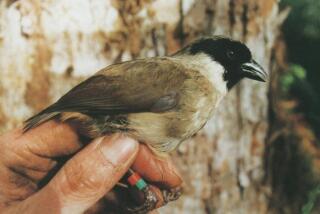Should pygmy three-toed sloths leave Panama for Dallas?
- Share via
A rare pygmy three-toed sloth stirred an international controversy after officials of the Dallas World Aquarium caught and crated six of the creatures on Isla Escudo de Veraguas, an island off Panama. The aquarium officials intended to take the animals back to Dallas — and made it clear they had extensive paperwork and permits to do so — but were confronted at the Isla Colón International Airport in the Bocas del Toro province of Panama by protesters and police who barred them from leaving the airport with the sloths. The animals were returned to the island.
The confrontation occurred in September, but the Animal Welfare Institute has just filed an emergency petition to list the pygmy three-toed sloth as endangered under the U.S. Endangered Species Act. Once an animal is protected under the U.S. act or under the international treaty CITES — the Convention on International Trade in Endangered Species of Wild Fauna and Flora — rigid restrictions on import and export go into place. A listing won’t prevent all import and export, but it will set conditions for it.
And it’s probably time to get the world’s smallest sloth listed as endangered. First identified as a distinct sloth species in 2001, it lives only in the mangroves of Isla Escudo de Veraguas. I’ve seen reports that put its total wild population at anywhere from 79 to 200. And, of course, they — or rather their fans — have their own Facebook page.
This doesn’t appear to be an issue of the Dallas World Aquarium having done anything technically wrong. The aquarium is involved in extensive conservation efforts across Latin America, including on the island pygmy sloths call home. The aquarium’s aim, its officials say, was to further that conservation effort by bringing back the sloths to breed and ensure the survival of the species. The Animal Welfare Institute, however, counters that the species does not do well in captivity.
The bigger question here, for all zoos and aquariums, is whether they should be capturing animals from the wild at all. Long gone are the days when gorillas and great apes were caught in the wild and brought to zoos. With the advent of international treaties and efforts to preserve species in their natural habitats, most zoos acquire their animals through zoo births and from other zoos and institutions. Members of the Assn. of Zoos and Aquariums (Dallas World Aquarium is one) sign on to a Species Survival Plan for animals that allows them to move animals around their zoos to best suit breeding needs and — hopefully — accommodate individual animals. (And that’s controversial enough among animal welfare advocates.) The zoo association, in its guidelines, admits that “it may be necessary to acquire wild-caught specimens” but urges its members to look to other institutions first and to consider the effect that taking an animal from the wild will have on the viability of the population it’s being taken from.
I doubt there are any pygmy sloths in North American zoos. So this situation poses an interesting dilemma: If there are only, say, 100 pygmy sloths in Panama, do you take 6% of the population in hopes of nurturing the animals into a thriving species in a controlled and monitored environment like the Dallas aquarium? Or do you leave them in place and do what you can to monitor the natural habitat in hopes of getting the species to thrive?
If the pygmy sloth gets an endangered listing, any institution that wants to take them off their island will have to make a compelling case for that.
ALSO:
Would you break the law for your family?
McManus: JFK, a presidency on a pedestal
Esperanza Spalding: Music to shine a light on Guantanamo Bay
More to Read
A cure for the common opinion
Get thought-provoking perspectives with our weekly newsletter.
You may occasionally receive promotional content from the Los Angeles Times.










